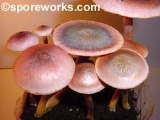
Gymnopilus aeruginosus
Encyclopedia
Gymnopilus aeruginosus, also known as the Magic Blue Gym, is a mushroom which grows in clusters on dead wood and wood chip mulch. It is widely distributed and common in the Pacific Northwest
. It has a rusty orange spore print and a bitter taste and contains the hallucinogen psilocybin
. It was given its current name by mycologist Rolf Singer
in 1951.
. They are roughened and elliptical. Pleurocystidia are rare and clamp connections are present. The basidia each have four spore. Gymnopilus aeruginosus has a rusty to rusty-orange or rusty-cinnamon spore print
.
, it also grows in some of the southern states of the United States, such as Tennessee
, and Georgia
. It is also found in Japan
and Korea
.
Pacific Northwest
The Pacific Northwest is a region in northwestern North America, bounded by the Pacific Ocean to the west and, loosely, by the Rocky Mountains on the east. Definitions of the region vary and there is no commonly agreed upon boundary, even among Pacific Northwesterners. A common concept of the...
. It has a rusty orange spore print and a bitter taste and contains the hallucinogen psilocybin
Psilocybin
Psilocybin is a naturally occurring psychedelic prodrug, with mind-altering effects similar to those of LSD and mescaline, after it is converted to psilocin. The effects can include altered thinking processes, perceptual distortions, an altered sense of time, and spiritual experiences, as well as...
. It was given its current name by mycologist Rolf Singer
Rolf Singer
Rolf Singer was a German-born mycologist and one of the most important taxonomists of gilled mushrooms in the 20th century....
in 1951.
Cap
The cap is (2) 5 – 15 cm (23) across, convex with an incurved margin and expands to broadly convex to almost plane in age. The top is dry, fibrillose, and scaly, often with a blueish-green tinge when young. The color is variable, often with various bluish green, pink, or vinaceous patches. The cap is sometimes cracked in age. The flesh is pallid to whitish, sometimes turning buff or pinkish-buff in age. The scales are tawny or reddish becoming dark brown, even the margin.Gills
The gills are close or crowded, and broad. They are buff to yellow-orange or ochre, and adnexed to adnate. They are at first slightly decurrent, often seceding. The edges are even to slightly rough.Spores
Spores are 6—9 µm by 3.5—4.5 µm and have no germ poreGerm pore
A germ pore is a small pore in the outer wall of a fungal spore through which the germ tube exits upon germination. It can be apical or eccentric in its location, and, on light microscopy, may be visualized as a lighter coloured area on the cell wall....
. They are roughened and elliptical. Pleurocystidia are rare and clamp connections are present. The basidia each have four spore. Gymnopilus aeruginosus has a rusty to rusty-orange or rusty-cinnamon spore print
Spore print
thumb|300px|right|Making a spore print of the mushroom Volvariella volvacea shown in composite: mushroom cap laid on white and dark paper; cap removed after 24 hours showing pinkish-tan spore print...
.
Stipe
The stipe is (3) 5 – 12 cm long, (0.4) 1.0 — 1.5 cm (4) thick, and has a more or less equal structure. It is covered with wikt:appressed fibrils, soon disappearing. It is smooth, dry, dusted with rusty orange spores and has a cottony, scanty, yellowish, partially fibrillose veil that leaves an evanescent zone of hairs near the apex of the stipe. It is colored more or less like the cap; it is flesh whitish, tinged greenish or bluish green, becoming yellowish or pinkish brown when dry. It is solid but becomes hollow, and is sometimes striated.Habitat and formation
Gymnopilus aeruginosus grows gregariously to cespitosely on stumps, logs, and woodchip mulch/sawdust on hardwood and conifers; Gymnopilus aeruginosus grows in spring, fall, and winter, common in the Pacific NorthwestPacific Northwest
The Pacific Northwest is a region in northwestern North America, bounded by the Pacific Ocean to the west and, loosely, by the Rocky Mountains on the east. Definitions of the region vary and there is no commonly agreed upon boundary, even among Pacific Northwesterners. A common concept of the...
, it also grows in some of the southern states of the United States, such as Tennessee
Tennessee
Tennessee is a U.S. state located in the Southeastern United States. It has a population of 6,346,105, making it the nation's 17th-largest state by population, and covers , making it the 36th-largest by total land area...
, and Georgia
Georgia (U.S. state)
Georgia is a state located in the southeastern United States. It was established in 1732, the last of the original Thirteen Colonies. The state is named after King George II of Great Britain. Georgia was the fourth state to ratify the United States Constitution, on January 2, 1788...
. It is also found in Japan
Japan
Japan is an island nation in East Asia. Located in the Pacific Ocean, it lies to the east of the Sea of Japan, China, North Korea, South Korea and Russia, stretching from the Sea of Okhotsk in the north to the East China Sea and Taiwan in the south...
and Korea
Korea
Korea ) is an East Asian geographic region that is currently divided into two separate sovereign states — North Korea and South Korea. Located on the Korean Peninsula, Korea is bordered by the People's Republic of China to the northwest, Russia to the northeast, and is separated from Japan to the...
.

